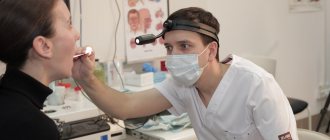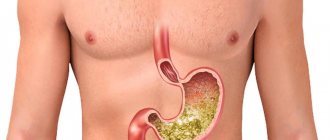- The structure of ENT organs in children
- Physiological features of the cough reflex
- Causes of cough in children
- Does it occur in a healthy person?
- Classification
- What does a severe cough mean?
- What is dry cough
- What to do with a barking cough
- Prevention and treatment of false croup
The structure of ENT organs in children
The human respiratory system has three sections: upper (nose, pharynx), middle (larynx, trachea, bronchi) and lower (alveoli, bronchioles). At birth, the respiratory tract is in the stage of formation, which is associated with the functional characteristics of the breathing of babies. By the age of seven, the development of the respiratory system enters its final stage, after which its size increases.
Children have a narrower lumen of the larynx, and the mucous membrane is thin and tender. The submucosal layer is loose and richly supplied with blood. The cartilage that forms the frame of the respiratory tract is pliable and soft. The above explains the vulnerability of the mucous membrane and the predisposition to easier penetration of infectious and atopic agents into the bloodstream. When inflammation occurs due to swelling, the airways narrow, making it difficult to breathe normally. The glands may secrete excess mucus. During the day, when the child is active, mucus drains well from the respiratory tract, but at night it can irritate the larynx. Separately, it is worth mentioning the reduced production of immunoglobulins and other immunity factors compared to adults.
Physiology of cough
The ability to effectively cough up sputum develops by the age of 4-6 years. Until this age, it, being in the respiratory tract, can interfere with normal breathing. Sputum secretion with normal rheological properties is formed by 5-6 years. Cough medications can be harmful to a young child because, with excess mucus and weakness of the respiratory muscles, they can worsen the cough and cause complications.
Bromhexine for children
The drug bromhexine is actively used in pediatric practice and has various release forms suitable for children: syrup, mixture (solution), low-dose tablets (4 mg).
The effect of bromhexine is based on the drug’s ability to thin mucus and facilitate its removal from the child’s respiratory tract.
Cough syrup for children
syrup is very easy to use, has a fruity taste and children drink it with pleasure. The syrup is prescribed to children from two years of age. This is due to the fact that children under one year old cannot cough on their own and they may experience stagnation of sputum in the bronchi. The accumulation of sputum can lead to a deterioration in the child’s condition and a protracted course of the disease.
Can children take cough drops?
The administration of tablets with a pediatric dosage of 4 mg is permitted from 3 years of age. Bromhexine is also available in a drinking solution and drops, which contain medicinal plant oils. These forms are used only for children over 12 years of age, since the composition contains ethanol.
During treatment with bromhexine, the child should be given enough fluids. To improve the removal of mucus from the bronchi, it is useful to massage the chest, especially for young children. And be sure to consult a doctor before using the drug.
Causes of cough in children:
– irritation of the mucous membrane of the respiratory tract due to or without infection;
– obstruction of the respiratory tract (entry of foreign particles or objects into the trachea and bronchi);
- compression of the respiratory tract.
In general, there are many causes of cough, including those associated with serious pathologies, but we will not touch on them in this article.
Prevention
Prevention of dry cough in a child is a prevention of respiratory tract diseases. To prevent these diseases, there are generally accepted recommendations:
- regular exposure to fresh air;
- outdoor games and physical education;
- balanced and regular nutrition;
- healthy sleep of at least 7 hours;
- avoiding hypothermia;
- avoiding contact with sick people;
- hand washing;
- vaccination.
If a child has increased sensitivity of the bronchi to irritants, it is recommended to carry out wet cleaning in the living space more often in order to reduce the concentration of dust and possible allergens. It is also necessary to correctly select sports and other physical activities for the child in order to develop and strengthen the respiratory system. So, playing a wind musical instrument can be a good breathing exercise.
Does a healthy child have a cough?
In 90% of cases, cough is a symptom of an acute respiratory disease with localization of the inflammatory process in the nose, nasopharynx and oropharynx or in the lower respiratory tract. However, the cough reflex is a mechanism for protecting the mucous membrane of the respiratory tract from various pathogens, including viruses.
Ciliated epithelial cells, making oscillatory movements, contribute to the formation of a protective mechanism called mucociliary clearance (MCC - a mechanism for cleaning the respiratory tract from foreign particles, including infectious ones):
– bronchi;
– trachea;
- nasal cavity. MCC in healthy children under normal conditions is the main mechanism for cleansing the trachea and bronchi.
Clearing the lower respiratory tract of foreign particles occurs due to the transport of tracheobronchial mucus and its subsequent elimination. Mucus has a bactericidal effect because it contains immunoglobulins and has certain properties - liquid, viscous, elastic.
Healthy children can cough up to 5-6 times a day, an infant up to 11 times during teething due to excessive salivation. A night cough is almost certainly a sign of illness.
With inflammation of the respiratory tract, mucus production may increase, sputum becomes more viscous, and the drainage function of the ciliated epithelium is inhibited.
In young children, the cough reflex is still imperfect. Therefore, with inflammatory diseases of the respiratory tract in infants, cough may be absent. In infancy, it weakens the baby, makes it refuse to eat, and regurgitates food.
Foreign object in the respiratory tract
The development of coughing attacks can be triggered by the penetration of a foreign object into the respiratory tract. In this case, the child becomes very anxious. Shortness of breath occurs, the cough is painful, dry, reflex.
In this case, it is very important not to panic. It is necessary to calm the baby so that he can breathe more calmly. Next, it is imperative to call emergency help as quickly as possible, since the effectiveness of treatment depends on how promptly parents contact specialists.
Cough classification
- by nature: unproductive (dry), productive (wet);
- by intensity: cough, mild, strong;
- by duration: episodic, short-term, paroxysmal, constant;
- according to the course: acute (up to three weeks), prolonged (more than 3 weeks, but less than 8 weeks), chronic (8 weeks or more);
- by depth and strength: sharp, strong and superficial (coughing);
- due to: infectious (viruses, bacteria, fungi), non-infectious (foreign body, dust, dry air, etc.), allergic
| Character | Activity | intensity | Flow | Depth and strength | Cause |
| unproductive (dry) | episodic | coughing | acute (up to 3 weeks) | sharp strong | Infectious (viruses, bacteria, fungi) |
| productive (wet) | short-term | easy | long-term(3-8 weeks) | superficial (coughing) | Non-infectious (foreign body, dust, dry air, etc.) |
| strong | chronic (from 8 weeks) | allergic |
Why does a child develop a dry cough without fever?
A dry cough without mucus discharge may be an accompanying symptom:
- the initial phase of acute laryngitis, bronchitis, pneumonia;
- attack of bronchial asthma;
- catarrhal period of whooping cough;
- entry of a foreign body;
- active and passive smoking, inhalation of any irritating substances;
- post-infectious cough after viral infections of the upper respiratory tract;
- drainage of mucus (discharge) along the back wall of the pharynx with rhinitis, pharyngitis, adenoiditis and sinusitis
- gastroesophageal reflux;
- compression of the respiratory tract;
- lung diseases;
- heart failure;
- use of medications (example: beta-blockers);
- irritation of cough receptors in the external auditory canal due to the accumulation of earwax, otitis media;
- psychogenic cough
Wet cough, like dry cough, has a number of causes, the most common of which are bronchopulmonary inflammatory processes, bronchitis and pneumonia.
A description of the color and consistency of sputum helps determine the likely cause of the disease. A yellowish-greenish tint to the sputum indicates a bacterial infection that needs to be treated. The inclusion of the drug VIFERON Rectal Suppositories in the treatment regimen helps reduce the likelihood of complications of ARVI, including the development of a bacterial infection.
Features of some types of dry cough
- laryngitis – barking, hoarse cough, hoarseness and change in voice
- true and false croup – barking, unproductive
- acute viral infections of the respiratory tract, rhinitis, adenoiditis, sinusitis - coughing of moderate intensity with coughing up draining mucus without sputum
- pharyngitis - sore or sore throat
- tracheitis, bronchitis – chest pain, rough, painful cough
Broncho-obstructive syndrome
Another cause of coughing attacks is broncho-obstructive syndrome. This is accompanied by prolongation of exhalation, the appearance of whistling noisy breathing, and attacks of severe suffocation. The cough is most often unproductive and annoying.
Broncho-obstructive syndrome develops due to the development of viral respiratory infections. The development is also caused by contact with an allergen, this is one of the signs of bronchial asthma.
To diagnose broncho-obstructive syndrome, doctors prescribe chest x-rays and spirometry. To exclude the allergic origin of the disease, a consultation with an allergist is scheduled. An effective treatment method is inhalation therapy.
What does a severe cough in a child without fever mean?
Upper respiratory tract infections in primary school and kindergarten age children, accompanied by a cough reflex, can occur 7-10 times a year. The appearance of this symptom during ARVI can be combined with fever and other catarrhal manifestations.
With pneumonia, in most cases (up to 70%), the cough is deep and wet literally from the first hours, wheezing and weakening of breathing can be heard.
Parents' attention and immediate reaction should be drawn to a sudden cough, which is dangerous because it can be caused by a foreign body entering the respiratory tract and suffocation. During the period of mass spread of viral diseases, I would like to note a post-viral cough, which begins with an upper respiratory tract infection and lasts more than three weeks. During this time, it ceases to perform its protective function; without treatment it can last up to 8 weeks or more. Its main cause is hyperactivity of cough reflexes.
A prolonged cough in a child without fever due to adenoiditis, nasopharyngitis can be either dry or productive; treatment of inflammation in the nasopharynx helps stop attacks. It is mainly characterized by inflammation of the nasopharynx and the flow of mucus from the nasal cavity along the back wall of the pharynx into the hypopharynx, entering the vestibular part of the larynx, which leads to stimulation of the cough reflex, dryness of the mucous membrane when breathing through the mouth.
A night cough is almost certainly a sign of a disease, for example, bronchial asthma, or may indicate an allergy to the contents of the pillow (down, feathers), or gastrointestinal problems.
Cough reflex when the air is dirty and dry. It has been proven that a passive smoker receives 20% of harmful substances from the amount that someone who smokes receives. Passive smoking also increases the likelihood of sinusitis, otitis media, bronchitis and contributes to the birth of babies with various pathologies.
Diagnosis of pathology
A pulmonologist diagnoses a cough, but if a cough is detected in a child, you should first contact a pediatrician, because a cough is not always a consequence of respiratory diseases or pathologies of the ENT organs.
Diagnosis of a disease with dry cough includes:
- Assessment of cough characteristics (rhythm, timbre, intensity).
- Instrumental examination - pharyngoscopy and laryngoscopy. Bronchoscopy and contrast bronchography are also prescribed if pathology in the bronchial structures is suspected. Listening to a cough is of great importance for diagnosis.
- Laboratory testing - a throat swab for bacterioscopy helps to establish the cause of the disease. A blood test (using ELISA, PCR or RIF methods) determines the amount of antibodies to various pathogens. A biochemical blood test is performed to detect signs of acute inflammation. Immunograms are performed if an allergy is suspected. If tuberculosis is suspected, a tuberculin test is taken.
- X-ray examination - X-ray or computed tomography is indicated to evaluate the involvement of mediastinal structures.
When respiratory causes of cough are excluded, additional diagnostic methods are used: ECG, ultrasound of the heart, contrast radiography of the esophagus. Some require consultation with an immunologist-allergist.
What is a dry psychogenic cough in children
Another type that parents should pay attention to: psychogenic. It usually occurs in response to a stressful situation in the family or school, then becomes habitual. It may be worth reducing the burden on the child. Coughing can serve as a way to achieve your goal, reducing stress, for example, while waiting for a doctor's appointment, stopping after its completion. A new attack can be provoked by touching upon a topic that is unpleasant for the child in a conversation, or if no attention is paid to the child or adolescent. Such attacks appear only during the daytime and disappear during conversation, sleep, and eating. The cough reflex is reinforced if the parents' attention is focused on the child's respiratory symptoms. However, it requires diagnosis to exclude organic causes.
Questions and answers
— Which doctor treats a child’s dry cough?
— First, you need to contact a pediatrician for initial diagnosis and obtain a referral for the necessary tests. After receiving the research results, consultation with an otolaryngologist, pulmonologist, immunologist, infectious disease specialist, cardiologist, gastroenterologist or surgeon may be required.
— Is it possible to treat a dry cough in a child with folk remedies?
— No, because folk remedies have no proven effectiveness and can be harmful. To receive adequate treatment, it is important to consult a doctor promptly and undergo diagnostics to determine the causes of a dry cough.
— Is it possible to attend kindergarten if a child coughs?
- No, you need to stay home and see a doctor. In kindergarten, a child can spread the infection to other children.
What to do if a child has a barking cough with fever
Parents of boys and girls under 6-8 years of age may have encountered nightly attacks of a loud barking cough when a child suffering from acute respiratory infections suffocates at a high temperature.
Acute attacks plus nasal congestion, sore throat, hoarseness, difficulty in breathing, and a preceding barking cough are a sign of acute stenosing laryngotracheitis or false croup (FC). The development of laryngeal edema, accumulation of mucus and muscle spasm against the background of inflammation can create a threat of asphyxia. LC is a complication of viral infections, most often parainfluenza, influenza, and can also occur with measles, rubella, chickenpox, diphtheria and scarlet fever. The likelihood of edema in a dry, overheated room in the autumn-winter period is quite high. Most often, the acute form of laryngotracheobronchitis develops in children of the second and third year of life (more than 50% of cases), somewhat less often - in infancy (6 - 12 months) and in the fourth year of life. In boys, this complication is observed almost 3 times more often than in girls. The cause of LC is not an allergy, but a virus. If a child has a seizure during which he experiences difficulty breathing, it is necessary to urgently call an ambulance. Before the doctors arrive, you can take a number of measures on your own, having previously agreed with your doctor: lower the air temperature in the room and increase the humidity: you can hang the radiators with wet towels, turn on the humidifier, calm down yourself and calm the child. You can distract your baby with a tablet, give him a drink of cold mineral water without gas or a lukewarm compote. It is possible to carry out inhalation with a drug prescribed by your doctor. It must be remembered that a warming compress, which mothers love so much, is contraindicated at high temperatures and fevers, as well as during the active phase of an infectious disease, so it is better to avoid this measure. Since hyperthermia causes additional swelling, a pediatric antipyretic may be given at high temperatures.
Sources
The following materials were used in preparing the article:
- Kazachkov M. Etiology and differential diagnosis of chronic cough in children. M.: Ross. Vestn. perinat. and Pediatrics, 2013.
- Mizernitsky Yu.L., Melnikova I.M. Mucoactive therapy for cough in children. M: Avers-Plus, 2014.
- Samsygina G. A. Cough in children. Clinical guidelines. M.: GEOTAR-Media, 2021.
- Tatochenko V.K. Differential diagnosis of cough in children and its treatment. M.: Attending physician, 2008.
- Chuchalin A.P., Abrosimov V.N. Cough. M.: GEOTAR-Media, 2021, 160 p.
Prevention and treatment of false croup in children
As a preventive measure for recurrent stenosing laryngotracheobronchitis in children, the antiviral drug VIFERON Gel can be used from the first days of life. For treatment in the acute period, if a complication has developed, VIFERON Gel is applied 5 times a day for 5-7 days, then 3 times a day for the next 3 weeks.
Last year, the Russian Medical Journal published an article “Acute respiratory infections in children: optimization of treatment tactics,” which presents research data on the use of the drug VIFERON in the treatment of acute respiratory viral infections and influenza. It is interesting that in children of different ages who received therapy with the inclusion of this drug, positive dynamics were observed faster, on average two days earlier than in the control group:
- body temperature tended to normal,
- symptoms of intoxication decreased,
- the intensity of catarrhal phenomena (cough, runny nose) decreased until it stopped
- respiratory syndrome (difficulty breathing)
Nosocomial infection becomes a common problem for patients undergoing treatment in a hospital. Infection threatens to delay treatment and develop complications in addition to the underlying disease. It is important that children who received VIFERON became infected half as often [1].
Reference and information material
Author of the article
Gerasimenko Igor Olegovich
General doctor
Sources:
- Nikolaeva S.V., Khlypovka Yu.N., Gorelov A.V. Acute respiratory infections in children: optimization of treatment tactics. //RMJ 2019; 1(*): pp.1-5.
i https://nczd.ru/
Loading...
Take other surveys





